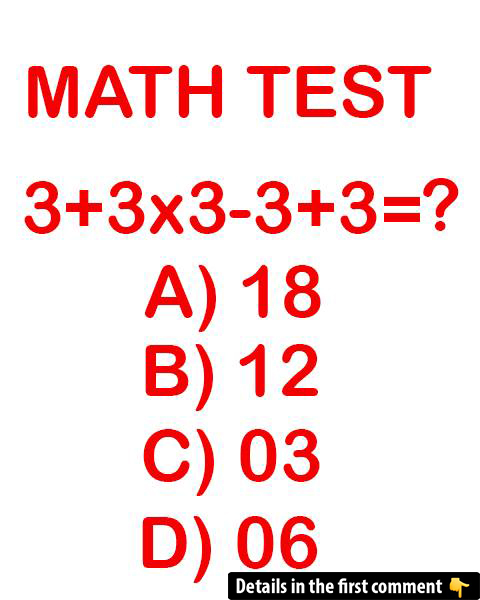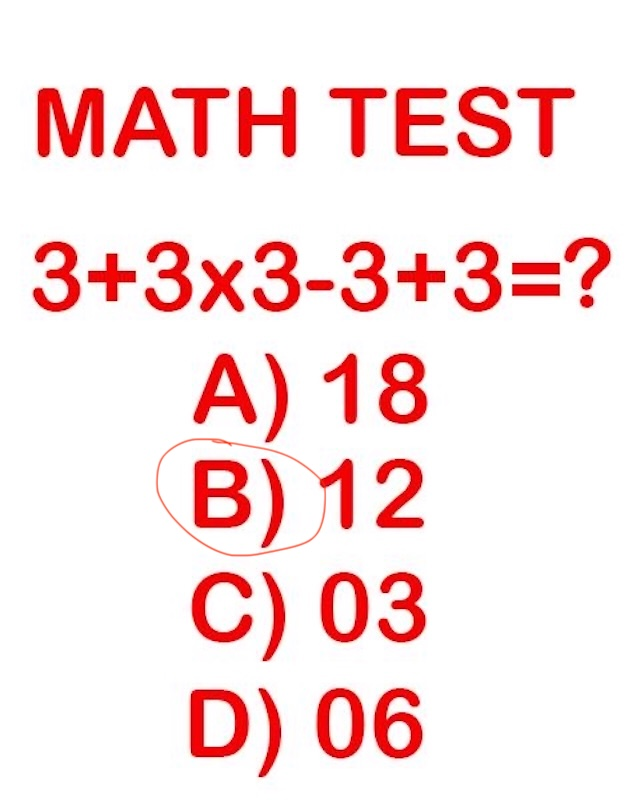Are you ready to put your math skills to the test? Sometimes, what looks like a simple equation can leave even the brightest minds scratching their heads. Today, we’re diving into a math puzzle that seems straightforward—but don’t be fooled. It’s all about understanding the proper order of operations.
Take a deep breath, focus your mind, and let’s see if you can crack this tricky math problem. Ready? Let’s jump in!

Can You Solve This Math Test?
Here’s the math challenge:
Question: 3 + 3 × 3 – 3 + 3 = ?
Take a moment to think through the problem before jumping to conclusions. It might look simple, but there’s more to it than meets the eye. Now, before we break it down, here are your answer choices:
- A) 18
- B) 12
- C) 03
- D) 06
Got your answer? Let’s see how well you did!
Video: A genius can solve in 10 seconds!
Why Do People Get This Wrong?
The most common mistake people make when solving this problem is ignoring the correct order of operations. You might remember the acronym PEMDAS from school:
- Parentheses
- Exponents
- Multiplication
- Division
- Addition
- Subtraction
This rule tells us that multiplication and division come before addition and subtraction, even if they appear later in the equation. When people rush or go left to right without thinking, they often end up with the wrong answer.
Let’s break down the problem step by step and see why following PEMDAS makes all the difference.
Step-by-Step Guide to Solving the Puzzle
Step 1: Start with Multiplication
PEMDAS tells us to handle multiplication before addition or subtraction. So, the first operation we tackle is:
- 3 × 3 = 9
Now, replace that part of the equation:
- 3 + 9 – 3 + 3 = ?
Step 2: Move to Addition and Subtraction (Left to Right)
Now that multiplication is done, we move on to addition and subtraction from left to right.
- Add 3 + 9 = 12
The equation now looks like this: 12 – 3 + 3 - Subtract 12 – 3 = 9
The equation now becomes: 9 + 3 - Finally, add 9 + 3 = 12
The correct answer is 12.
The correct choice from the options given is B) 12.

Why This Works: The Importance of PEMDAS
You might wonder why the answer isn’t 18, which some people mistakenly calculate. The error usually comes from doing the operations straight from left to right without following the order of operations.
If you do it in the wrong order, it might look like this:
- 3 + 3 = 6
- 6 × 3 = 18
- 18 – 3 = 15
- 15 + 3 = 18
While this might seem logical when moving left to right, it’s not mathematically correct because multiplication must come before addition or subtraction. That’s why PEMDAS is essential for solving these types of problems correctly.
Why Math Puzzles Are So Tricky
Math puzzles like this one are designed to catch you off guard. They look simple, but they test your ability to follow fundamental math rules. The biggest trap here is complacency—thinking you can just move from left to right without considering the correct sequence of operations.
Our brains are often wired to follow natural reading patterns—left to right—so it’s easy to forget the math rules. That’s why these puzzles are not just about calculation but also about critical thinking and discipline.
The Joy of Getting It Right

There’s something incredibly satisfying about solving a puzzle correctly, especially when it challenges your logic and reasoning. When you crack a problem like this, it’s not just about the answer—it’s about proving to yourself that you can think analytically and follow through without making common mistakes.
If you got it right on the first try, give yourself a pat on the back! You’ve got a good grasp of basic math rules. If you didn’t, don’t worry—now you know how to approach similar puzzles in the future.
Why Practice Makes Perfect
The more you practice math puzzles, the better you become at spotting patterns and avoiding common pitfalls. These exercises sharpen your problem-solving skills, enhance critical thinking, and boost your mental agility. Plus, they’re just plain fun!
Try incorporating a few math puzzles into your daily routine. You’ll be amazed at how quickly your brain adapts to spotting mistakes and thinking more logically.
Share Your Success!
Did you get the answer right? Share your thoughts in the comments below! If you got stuck at first, don’t worry—now you know the secret. Challenge your friends and family to see if they can figure it out as quickly as you did. You might be surprised at how many people get tripped up by this seemingly simple math problem.
Encourage others to think critically and follow the order of operations. It’s a great way to keep your brain sharp and have a little friendly competition!
Final Thoughts: Mastering Math Puzzles
Math puzzles are more than just numbers—they’re exercises for your brain. The key to solving them correctly lies in remembering fundamental math principles, like the order of operations. Next time you come across a tricky equation, take a moment to think it through, apply PEMDAS, and avoid rushing to the answer.
By practicing regularly, you’ll not only become more confident in solving math problems but also develop a more analytical mindset. Keep challenging yourself with more puzzles, and soon you’ll be solving them faster and more accurately.
Math doesn’t have to be intimidating. With a little practice and the right mindset, you can master even the trickiest equations. Keep learning, stay curious, and always enjoy the challenge!


